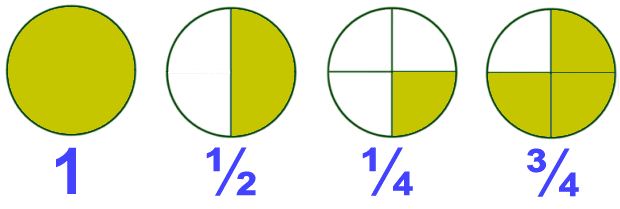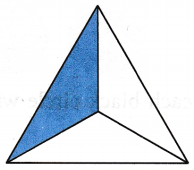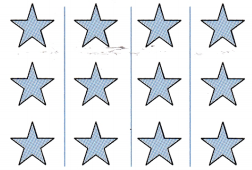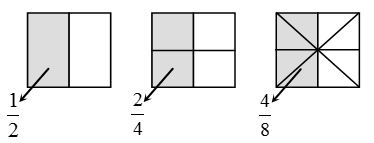What is Fraction and How many Types of Fractions are there
Fraction
A number that compares part of an object or a set with the whole, especially the quotient of two whole numbers is written in the form of xly is called a fraction. The fraction 1/3, which means 1 divided by 3, can be represented as 1 pencil out of a box of 3 pencils.
A fraction is a (i) part of a whole. (ii) part of a collection.

A fraction comprises two numbers separated by a horizontal line. The number above-the horizontal line is called the numerator and the number below the horizontal line is called the denominator of the fraction.

Fraction as a part of a whole
A fraction is a part of a whole. Imagine a pizza cut into slices. All of the slices make 1 whole pizza. Each slice is a fraction of a pizza.
Tanya and Sanya want to share a pizza equally
 They decide to cut the pizza from the middle and divide it into two equal parts. Each part is called
They decide to cut the pizza from the middle and divide it into two equal parts. Each part is called
the half of the whole and written as \(\frac{1}{2}\). Both the sisters get equal share. The \(\frac{1}{2}\) part of the whole is a fraction.
 Similarly, we can take many examples from our daily life to show fraction as a part of a whole.
Similarly, we can take many examples from our daily life to show fraction as a part of a whole.
 In this figure we have divided a triangle into 3 equal parts. The shaded part shows one part out of three, i.e., \(\frac{1}{3}\). Here, \(\frac{1}{3}\) is a fraction, which is a part of the whole triangle.
In this figure we have divided a triangle into 3 equal parts. The shaded part shows one part out of three, i.e., \(\frac{1}{3}\). Here, \(\frac{1}{3}\) is a fraction, which is a part of the whole triangle.
Read More:
- Comparing and Ordering of Fractions
- Conversion of Decimal into Fraction
- Operations on Fractions
- RS Aggarwal Class 6 Solutions Fractions
- RS Aggarwal Class 7 Solutions Fractions
Fraction is a part of a collection
A fraction represents parts of a collection, the numerator being the number of parts we have and the denominator being the total number of parts in the collection.
Let us take a collection of 12 stars and we want to shade \(\frac{3}{4}\) of the collection.
 In order to find \(\frac{3}{4}\) out of the 12 stars, we divide the 12 stars into four equal parts.
In order to find \(\frac{3}{4}\) out of the 12 stars, we divide the 12 stars into four equal parts.
 Each part contains 3 stars. Now, we can shade 3 parts out of 4 parts.
Each part contains 3 stars. Now, we can shade 3 parts out of 4 parts.
 On counting, we find that the total number of shaded stars is 9.
On counting, we find that the total number of shaded stars is 9.
In other words, \(\frac{3}{4}\) of 12 stars = 9 stars.
Types of fractions
- Like fractions: Fractions having the same denominators are called like fractions.
Examples: \(\frac{1}{7}\), \(\frac{3}{7}\), \(\frac{2}{7}\), \(\frac{6}{7}\) etc. are like fractions. - Unlike fractions: Fractions having different denominators are called unlike fractions.
Examples: \(\frac{2}{3}\), \(\frac{5}{7}\), \(\frac{6}{8}\), \(\frac{1}{3}\) etc. are unlike fractions. - Unit fraction: A fraction having a numerator as 1 is called a unit fraction.
Examples: \(\frac{1}{3}\), \(\frac{1}{9}\), \(\frac{1}{8}\), \(\frac{1}{5}\) etc. are all unit fractions - Proper fraction: A fraction, whose numerator is smaller than its denominator is called a proper fraction.
Examples: \(\frac{2}{3}\), \(\frac{5}{7}\), \(\frac{1}{6}\), \(\frac{3}{9}\) etc. are all proper fractions. - Improper fraction: A fraction, whose numerator is greater than or equal to its denominator is called an improper fraction.
Examples: \(\frac{4}{3}\), \(\frac{7}{5}\), \(\frac{9}{9}\) etc. are all improper fractions. - Mixed fraction: A fraction, which is a combination of a whole number and a proper fraction is called a mixed fraction. All improper fractions can be written in the form of mixed fractions.
Example: 2 \(\frac{1}{4}\) is a mixed fraction, since 2 is a 4 whole number and \(\frac{1}{4}\) is a proper fraction.

- Equivalent Fraction: If \(\frac { c }{ d } =\frac { m\times a }{ m\times b }\), then the fractions \(\frac{a}{b}\) and \(\frac{c}{d}\) are called equivalent fractions because they represent the same portion of the whole.

For example, the shaded parts of each of the following figures are same but they are represented by different fractional numbers.

They are called equivalent fractions.
So we write \(\frac { 1 }{ 2 } =\frac { 2 }{ 4 } =\frac { 4 }{ 8 }\) , etc. - Decimal fractions: A fraction whose denominator is any of the number 10,100,1000 etc. is called a decimal fraction.
For example : \(\frac { 8 }{ 10 } ,\frac { 11 }{ 100 } ,\frac { 17 }{ 1000 }\) etc. are decimal fractions. - Vulgar fractions: A fraction whose denominator is a whole number, other than 10,100,1000 etc. is called a vulgar fractions.
For example \(\frac { 2 }{ 7 } ,\frac { 3 }{ 8 } ,\frac { 11 }{ 17 }\) etc. are vulgar fractions.
